Abstract
The difference in ozone (O3) concentration between stations in the urban and southern mountainous areas of Urumqi was explored based on mathematical statistics and comparative analysis of pollutant concentrations. Besides, potential source contribution function (PSCF) analysis and concentration weighted trajectory (CWT) analysis were performed to identify the potential sources of PM2.5 and O3. The results showed that the daily and monthly mean O3 concentrations in the urban area of Urumqi showed a bimodal variation from October 2017 to August 2018, and the O3 concentration had obvious seasonal characteristics, with the highest in July (120.57 μg/m3) and the lowest in January (22.38 μg/m3). The overall variation of O3 concentration in the mountainous area in the southern suburb of Urumqi was not significant (56.69–84.06 μg/m3), and the O3 concentration was slightly higher in summer than in other seasons. The daily O3 concentration in the urban area showed a unimodal variation in all seasons, and the daily variation was the smallest in winter and the largest in summer. However, the daily variation in the mountainous area was not significant. The O3 concentration in the urban area showed a significant negative weekend effect in winter and a positive weekend effect in spring and summer. However, the O3 concentration only showed a significant positive weekend effect in the mountainous area in summer. The PSCF and CWT analysis results of urban O3 concentration showed that Urumqi, Shihezi, and Wusu were the main O3 source areas. In addition, some areas bordering Kazakhstan in Xinjiang, China were also important source areas.
1. Introduction
The implementation of the Action Plan for Air Pollution Prevention and Control and the Three Year Blue Sky Action Plan has significantly improved China’s air quality. Especially, the PM2.5 concentration and the number of days with PM2.5 pollution and severe air pollution have significantly decreased in the Beijing-Tianjin-Hebei region and its surrounding areas. However, it also should be noted that in recent years, the O3 concentration and the number of days with severe O3 pollution have obviously increased in some urban areas in China [1,2,3]. Besides, the scope, duration, and extent of O3 pollution have also increased obviously [4]. Some studies have shown that in China’s major economic zones, complex air pollution caused by PM2.5 and O3 occurs more and more frequently [5,6,7,8], which greatly threatens human health. High concentrations of O3 can lead to reduced crop yields and slow tree growth [9], and the strongly oxidizing properties of O3 can irritate the respiratory tract [10], causing acute symptoms such as chest tightness, dizziness, dyspnea, and even death [11]. Relevant epidemiological studies have found [12,13,14,15] that the concentration of fine particulate matter and O3 in the surface layer is significantly correlated with respiratory diseases, cardiovascular diseases, chronic diseases, and population deaths.
The Fourth Assessment Report of the Intergovernmental Panel on Climate Change (IPCC) shows that global warming is a key factor limiting human development, and the cooling effect of PM and aerosols is much weaker than the warming effect of greenhouse gases [16]. Currently, there is a scientific consensus that human activities are dominant contributors to global warming. The synergistic effect of human activities and atmospheric processes has led to increased air pollution [17]. Long-term climate effect studies have shown that global warming causes an increase in O3 concentration [18], especially in urban areas where people have intensive activities. The increase in the O3 concentration [19] also exacerbates global warming, causing anomalous changes in the climate system. At present, in northwest China, extreme weather occurs frequently, and the temperature and precipitation continue to increase [20]. Therefore, it is necessary to analyze the concentration changes of important pollutants in urban areas of arid northwest China, which can improve our understanding of local climate change.
Urumqi, a core city in the economic belt on the north slope of the Tianshan mountains, has a higher population density than other cities in Xinjiang. Especially, the industries in Urumqi use coals and oils as the main energies. These factors make pollutant emissions in Urumqi significantly higher than those of other cities, causing frequent severe air pollution over the years. Especially, the increases in motor vehicles in recent years have weakened the effectiveness of air pollution control measures [21]. This type of pollution has become more and more complex. Urumqi has calmer weather, less rainfall, and weaker atmospheric turbulence in winter than in summer. However, during the heating season (winter), industrial coal-fired boiler emissions, the inversion layer, and the blocking effect of the Tianshan Mountains make the concentration of pollutants such as PM and nitrogen oxides significantly higher than that of other seasons. Fine particulate matter, O3, and NOX have a long residence time in the atmosphere and are easily transported to other areas [22,23,24,25]. It is important to note that aerosols (tiny particles that float in the air) affect photochemical reactions, radiation fluxes, etc., which ultimately affects O3 concentration. The increase in aerosols provides more sites for chemical reactions [26,27,28], resulting in complex types of generated pollutants that may harm human health [29,30]. Therefore, how to coordinate the control of PM2.5 and O3 has become the focus of air quality control in recent years.
In this study, the urban and southern mountainous areas (Baiyanggou) of Urumqi (distance: about 75 km; altitude difference: about 1100 m) were selected as the study areas. The changes in O3 concentration in the two areas from October 2017 to August 2018 were analyzed and the O3 concentration variation was compared with that of PM. Then, the Global Data Assimilation System (GDAS) weather reanalysis data obtained from the National Centers for Environmental Prediction (NECP) was combined with the HYSPLIT backward trajectory model, to explore the source areas of O3 in Urumqi urban area in four seasons and quantify the contributions of different source areas. This study will provide a reference for regional collaboration in PM2.5 and O3 pollution control.
2. Materials and Methods
2.1. Study Sites
Site 1: The Atmospheric Composition Observation Station of Urumqi Desert Meteorological Institute, China Meteorological Administration (Jianguo Road, Tianshan District, Urumqi, China) (87°64′ E, 43°80′ N, a.s.l. 941.3 m) was selected as the air sampling site in the urban area of Urumqi (Figure 1). It was surrounded by business districts and residential areas. The air sampling point was 26 m from the ground.
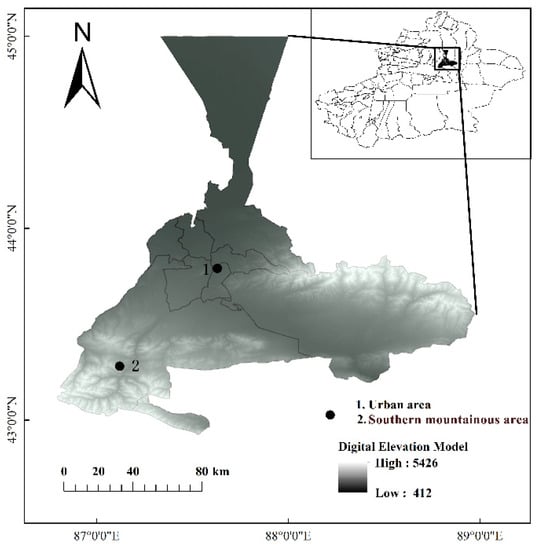
Figure 1.
Location of study sites.
Site 2: The Atmospheric Composition Observation Station of the Middle Tianshan Mountain Grassland Ecological Meteorological Monitoring Station of Urumqi Desert Meteorological Institute, China Meteorological Administration (87°12′ E, 43°28′ N, a.s.l. 2169 m) was selected as the air sampling site in the mountainous area. It is located in the southern suburb of Urumqi, about 75 km away from the urban area.
2.2. Data Sources
2.2.1. Particulate Matter and O3 Concentration Data
The hourly PM and O3 concentration of the two areas (October 2017–August 2018, 335 days) were obtained from the Atmospheric Composition Monitoring Station of the Institute of Desert Meteorology, China Meteorological Administration, Urumqi. The ML/EC 9810B ozone analyzer (produced by Ecotech Company in Croydon South, Australia) and the Grimm180 particle monitor were installed on the roof of the office building of the Xinjiang Autonomous Region Meteorological Bureau, without buildings and trees around. The 49i ozone analyzer (produced by Thermo Scientific Company in Waltham, MA, USA) and the Grimm180 particle monitor were installed on the roof of the office building of the Middle Tianshan Grassland Ecological Meteorological Monitoring Station, without buildings and trees around. The vertical distances between the instruments and the roofs were 1.5 m, and the vertical distances from the sampling ports to the ground were about 5.0 m. The minimum detection limit was 0.5 × 10−9 ppbv, and the precision was 1.0 × 10−9 s. All the instruments met the requirements of the U.S. Environmental Protection Agency, Washington, DC, USA. The O3 concentration was continuously observed online (stopped in case of power failure or instrument failure). The outputs were processed by Kalman filtering. To ensure data accuracy, the analyzers were calibrated every six months using the Thermo 49 ips ozone calibrator. The volume mixing ratio (VMR) of collected data (ppb) was converted into the mass concentration of O3 (μg/m3) according to the description in Air Quality—Determination of Ozone in Ambient Air—Ultraviolet Photometric Method (First Edition).
Hourly PM and O3 concentrations in the urban area were calculated from 5-min averages. The instrumental outputs for PM and O3 concentrations in the mountainous area were hourly data. The data were processed by the following procedure: Outliers caused by the instrument errors were removed from the raw data. After that, the remaining data were converted into daily averages, monthly averages, etc., by arithmetic averaging for further analysis. In this study, a total of 335 days of data were included in the analysis. The number of days with valid particulate matter data in urban and mountainous areas was 290 and 301, respectively, and that of days with valid ozone data were 288 and 291, respectively.
2.2.2. GDAS Data
The Global Data Assimilation System (GDAS) meteorological reanalysis data (temperature, pressure, horizontal and vertical wind speed, etc.) (spatial resolution: 1° × 1°) provided by the U.S. National Center for Environmental Prediction (NCEP) (available at ftp://arlftp.arlhq.noaa.gov/pub/archives/gdas1/, accessed on 18 October 2021) were used as inputs of the HYSPLIT model [31].
2.3. Hybrid Single-Particle Lagrangian Integrated Trajectory (HYSPLIT) Model
The HYSPLIT model jointly developed by the National Oceanic and Atmospheric Administration (NOAA) of the United States and the Australian Bureau of Meteorology (BOM) has been widely used to study the diffusion, transport, and sedimentation of atmospheric pollutants. It can analyze the pollutant sources and transport paths based on the airflow trajectory and pollutant concentration [32,33]. In this study, Site 1 is located in the downtown area of Urumqi, which is greatly affected by human activities. The change in O3 concentration is very large. Therefore, this site was selected for 48-h backward trajectory analysis. The simulated height was selected as 500 m. The cluster analysis, Potential Source Contribution Function (PSCF) analysis, and Concentration-weight Trajectory (CWT) analysis were performed with the TrajStat in Meteoinfo software (Version 3.2.4 and provided by Wang et al., Beijing, China) [34]. The Euclidean distance transform was used for cluster analysis. The grid size was 0.25° × 0.25°. Spring started in March and ended in May, summer started in June and ended in August, autumn started in September and ended in November, and winter started in December and ended in February of the next year. The PSCF and CWT analysis scopes were the same as that of the backward trajectory, and the grid size was 0.25° × 0.25°. For PSCF and CWT analyses, weight factors () were used to reduce the uncertainty caused by conditional probability [35,36,37]. PSCF analysis can only reflect the proportion of polluted trajectories in grids and cannot distinguish the concentration contribution level of the trajectories. The CWT analysis was conducted to calculate the concentration contribution of different potential sources. The formulas were as follows:
where represents the longitude and latitude of a grid, represents the number of trajectory endpoints in a grid, represents the number of trajectory endpoints passing through a grid, represents the average weighted concentration of the grid , represents the trajectory, represents the total number of trajectories, represents the pollutant concentration in a grid when trajectory l passes through the grid, and represents the duration that trajectory l stays in a grid.
3. Results and Discussion
3.1. Daily, Monthly, and Seasonal Changes of O3 Concentration
The O3 concentration in the air is affected by precursor emissions, chemical generation, chemical removal, meteorological conditions, air transmission, etc. [38,39,40,41,42]. O3 is generated when the atmosphere is present in the appropriate concentration of O3 precursors, such as carbon monoxide (CO), methane (CH4), and volatile organic compounds (VOCs). The photochemical reaction chain is catalyzed by hydroxide anion (OH−), hydrogen peroxyradical (HO2), and NO. Therefore, regardless of the external transport of surrounding areas and the diffusion of pollutants, the change in O3 concentration depends on the concentration of precursors such as nitrogen oxides and VOCs and the photolysis rate of NO2 [43]. It should be noted that O3 may also regenerate NO2 in the presence of NO, thus keeping a photo-stationary state.
In this study (Figure 2 and Figure 3), the daily and monthly average O3 concentrations varied insignificantly in the mountainous area and were slightly higher in April–August 2018 than at other times. However, the daily and monthly average O3 concentrations in the urban area showed a bimodal variation. The O3 concentration gradually rose from October 2017 to December 2018, reduced from December to January 2018, and then rose again, showing peaks in March 2018 and July 2018. This may be because Site 2 is located in the mountainous area of the southern suburb of Urumqi and is rarely affected by human activities, and the dense vegetation has a strong absorption effect on O3 precursors and other pollutants [44], leading to an insignificant change in O3 concentration. However, in summer, Urumqi’s vehicle emissions, industrial pollutant emissions, and other man-made pollutant emissions significantly increase, leading to an increase in nitrogen oxides and VOCs; at this time, the temperature is high and the UV radiation is strong. Thus, O3 is produced in large quantities in the urban area, leading to a sharp increase in O3 concentration. With the continuous increase of O3 concentration in the urban area, a portion of O3 diffuses to the mountainous area, resulting in fluctuations in O3 concentration in the mountainous area. On the other hand, the rapid increase in tourists in Baiyanggou in the summer leads to an increase in pollutants such as dust and vehicle exhaust, which promotes the generation of O3 under the catalysis of UV radiation.
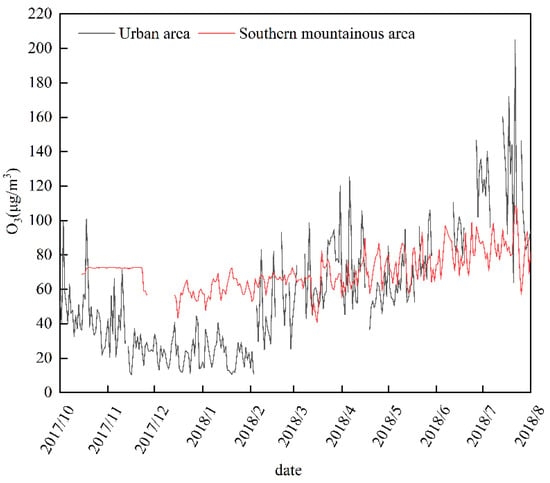
Figure 2.
Variation of daily average ozone concentration. The absence of some data in the figure is caused by instrument power failure and elimination of invalid data.
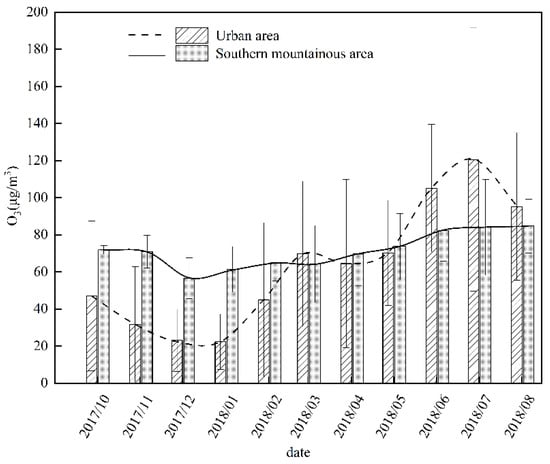
Figure 3.
Variation of monthly average ozone concentration.
In winter, the urban area of Urumqi has calmer weather, lower temperatures (−13–−4 °C), and shorter daily sunshine duration (9 h in winter, 14–16 h in summer) compared with the summer season, which is not conducive to the generation of O3. Thus, the O3 concentration is low in winter. With the gradual increase in UV radiation and temperature in early spring, the photochemical reaction is strengthened, leading to a significant increase in O3 concentration. Under high-intensity UV radiation and high air temperatures in summer, a large amount of O3 is generated, leading to the highest O3 concentration. This study found that the O3 concentration in the urban area was mostly lower than that in southern mountainous area before March. The fluctuations in the O3 concentration of southern mountainous area from March to May may be due to the pollutant transport from the urban area. Southern mountainous area is always in a relatively stable environment for the less human activities. Although the urban area has more O3 precursors due to human activities, industrial production, etc., compared with southern mountainous area, the lack of key driving factors such as meteorological conditions inhibits the generation of O3. The O3 generated by photochemical reactions is also less than the consumption. In addition, O3 also reacts with olefins, hydroxyl radicals, peroxy hydroxyl radicals, etc., which increases O3 consumption and significantly reduces O3 concentration. After May, high air temperature and high-intensity UV radiation greatly enhanced the photochemical reaction, resulting in the O3 generated being higher than the consumption. Compared with the urban area, the southern mountainous area has more rainfall in summer, which promotes the deposition of NO. It can be seen that climate, meteorological conditions, and NOX and VOC generation are the key factors affecting the O3 concentration in the two areas. The O3 pollution in the urban area is the result of the comprehensive effect of various factors.
The comparison of the O3 and PM concentration variations in the two areas (Figure 4) found that the seasonal variation of PM concentration was more obvious in the urban area than in the southern mountainous area. This may be due to the sand and dust storms in spring and the man-made pollutants such as smoke and dust generated by coal combustion in autumn and winter and motor vehicle exhaust are responsible for PM10 pollution. Besides, most PM2.5 and PM1 also come from man-made pollutant emissions [45]. It was also found that in the southern mountainous area, the O3 concentration in summer was more than twice that in winter, and the overall variation of O3 and PM concentration was not significant. This may be due to the dense vegetation in the southern mountainous area, leading to a small amount of pollutants generated but large pollutant adsorption.
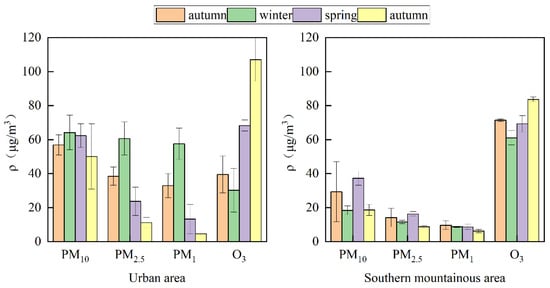
Figure 4.
Seasonal variation of particulate matter and ozone concentration.
3.2. Daily Variation of O3 Concentration
The daily variation of O3 concentration can be divided into four stages [46]: ① Nocturnal accumulation of O3 and its precursors; ② Suppression of O3 generation in the early morning; ③ Generation of O3 by photochemical reaction; ④ O3 consumption. In this study, in the mountainous area, the variation in O3 concentration was not significant (Figure 5). Besides, there were no significant diurnal variations in autumn, winter, and spring, but there were insignificant unimodal variations in summer. In the urban area, the daily O3 concentration presented an obvious unimodal variation, and the seasonal variation was also obvious. Besides, the O3 concentration changed significantly during the day and remained stable at night. From 1:00 a.m. to 4:00 a.m., O3 concentration was lowest of the day. This may be due to the intensity of human activities being low, leading to low concentrations of O3 and its precursors. From 4:00 a.m. to 8:00 a.m., human activities increased, and a large amount of vehicle exhaust was emitted, leading to an increase in O3 precursors. Due to the low-intensity UV radiation, the O3 consumption by NO was greater than the generation of O3, leading to a decrease in O3 concentration. From 8:00 a.m. to 3:00 p.m., O3 concentration gradually increased and reached the highest value. This may be due to the increases in temperature and UV radiation promoting the photolysis of NO2 and the generation of O3. At this stage, the production of O3 was greater than the consumption of O3, so O3 continued to accumulate and peaked at 3:00 p.m. After 3 p.m., with the decrease in UV radiation intensifying, the degree of photochemical reaction decreased, leading to a decrease in O3 concentration. O3 concentration remained at a low concentration at night [47].
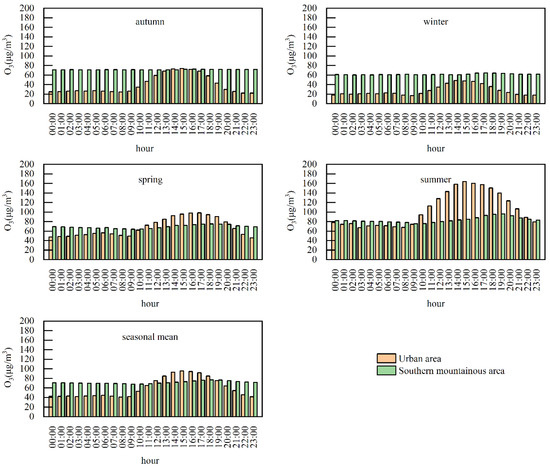
Figure 5.
Daily variation of ozone concentration.
There was a significant difference in O3 concentration between the two areas in different seasons. The O3 concentration in urban areas varied greatly between seasons, and the O3 concentration in summer was about three times that of winter. The daily variation varied significantly among different seasons, and that in the urban area showed a unimodal pattern in the four seasons. The daily variation was the smallest in winter and the largest in summer. This may be due to the high temperature and high-intensity UV radiation in summer. It was also found that in summer, the daily variation of O3 concentration in the southern mountainous area was small, and a peak appeared around 7 a.m., later than the appearance of O3 concentration peak in the urban area. This may be due to the fact that the O3 concentration is high in the urban area in summer, and it takes some time for O3 to diffuse from the urban area to the southern mountainous area.
3.3. Seasonal Weekend Effect of Ozone Concentration
The weekend effect of O3 concentration is different in different cities, due to differences in economic structure, human activities, pollutant emissions, etc. [48]. In this study (Figure 6), there was no obvious weekend effect in the urban area in autumn. However, there was an obvious negative weekend effect in winter and a positive weekend effect in spring and summer. Besides, the weekend effect in spring was stronger than that in summer. In the southern mountainous area, there was a negative weekend effect in autumn, winter, and spring, and the weekend effect continued to weaken from autumn to spring of the next year. Besides, there was a significant positive weekend effect in summer.
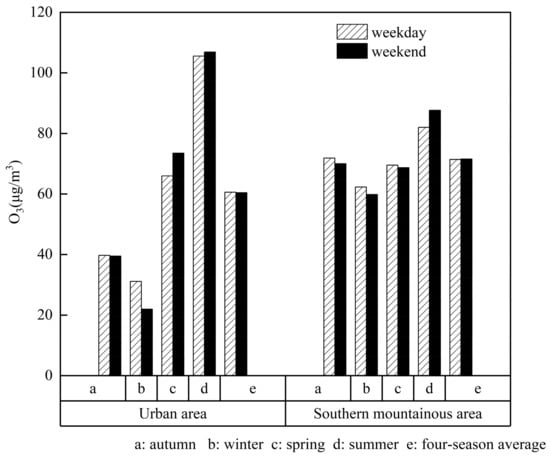
Figure 6.
Weekend effect of O3 concentration in different seasons.
The O3 concentration in the urban area is significantly affected by human activities, while that in the mountainous area is less affected by human activities. Urumqi has a long winter. In winter, the temperature is very low, and the lowest temperature is below −20 °C. The ground is slippery from frequent snowfall and low temperatures, resulting in a large reduction in residents’ travel activities on weekends (https://mp.weixin.qq.com/s/IxNK5e47_5D_LguukM02Mg, accessed on 13 March 2023). Due to the above factors, O3 precursor concentration decreases, causing O3 production to decrease. Therefore, the concentration of O3 on weekdays was higher than that on weekends, that is, the so-called “negative weekend effect”. In spring, due to the increase in temperature, human activities in the urban area increase on weekends, combined with the increase in UV radiation, making the O3 concentration rise sharply on weekends. In summer, the weather is hot, residents go out on weekends to increase, and many citizens go to the southern mountains to escape the heat, resulting in the O3 concentration in the urban area being slightly higher on weekends than on weekdays, while the O3 concentration in the southern mountainous area is significantly higher on weekends than on weekdays.
3.4. Relationship between Particulate Matter and O3 Concentration in the Urban Area of Urumqi
Previous correlation analyses of PM and O3 have yielded different conclusions due to differences in study location and time period [49,50]. In this study, the correlation analysis of pollutants in different months (Figure 7) found that PM1 was positively correlated with PM2.5 and PM1 and PM2.5 were negatively correlated with O3, this is consistent with the findings of Wang’s research [21]. The sources of PM1 and PM2.5 were similar. The increase in PM1 and PM2.5 inhibits the generation of O3 to some extent. The comparison of the monthly variation of PM1, PM2.5 and O3 in the urban area (Figure 8) showed that the concentration of fine PM (PM1 and PM2.5) was lower than 75 μg/m3 in each month, and the concentrations of PM2.5 and PM1 had similar variations. From June to July, O3 concentration was high in the urban area, and the variation of PM1 and PM2.5 was opposite to that of O3. By comparing the scatterplot and fitting curves of PM2.5 and O3, it was found that PM2.5 was negatively correlated with O3. This is consistent with the correlation analysis results. In addition, when PM2.5 was lower than 35 μg/m3, the concentration of O3 increased with the increase in PM2.5 concentration; otherwise, it decreased with the increase in PM2.5 concentration. The reduction in the concentration of fine PM could increase atmospheric visibility [51,52], and the high-intensity UV radiation is conducive to the generation of O3 [53,54]. However, the increase in PM2.5 concentration inhibits the generation of O3 to some extent [21,55]. The high temperature and high-intensity UV radiation in summer result in the production of a large amount of O3, which enhances atmospheric oxidation [56] and increases secondary aerosol concentration. This ultimately leads to PM2.5 and O3 pollution [57].
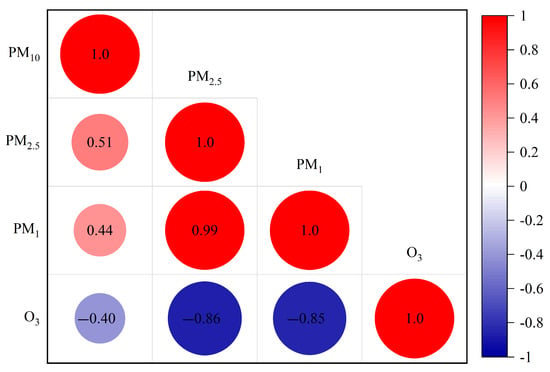
Figure 7.
Correlation analysis of PM2.5, PM1, and O3 concentrations.
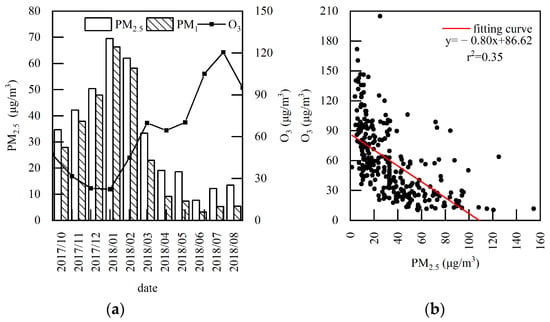
Figure 8.
Double Y-axis plot (a) and scatterplot (b) of the relationship between PM and O3 concentration.
3.5. Analysis of O3 Sources
Due to the significant impact of human activities in the urban area, O3 concentration varies greatly throughout the year, and O3 pollution is prone to occur. Therefore, the potential sources of O3 in the urban area from October 2017 to August 2018 were analyzed and compared with the sources of PM2.5. Zhu et al. [45] analyzed the air mass trajectories in Urumqi and found that the air masses in Urumqi were mainly from the northwest. Specifically, in autumn and winter, the air masses in the urban area were mainly from the Tianshan Mountain Economic Belt. In spring and summer, the air masses were mainly from Central Asia. The trajectories clustering using the HYSPLIT model can preliminarily determine the main directions and positions of air masses that affect air quality [58,59,60]. In this study, PSCF and CWT analysis were combined to determine the relative contribution of potential source areas to the O3 concentration in the urban area of Urumqi and the specific concentration contributions of different source areas.
3.5.1. PSCF Analysis
In the PSCF analysis (Figure 9), the color represents the contribution level of the potential source area. The darker the color, the larger the WPSCF value, and the greater the contribution of the area (grid) to the PM2.5 and O3 concentrations in the urban area of Urumqi. The WPSCF value was divided into three ranges: 0–0.3, 0.3–0.7, and 0.7–1.0, and the main source areas (MSAs) refer to the areas with a WPSCF value of 0.7–1.0.
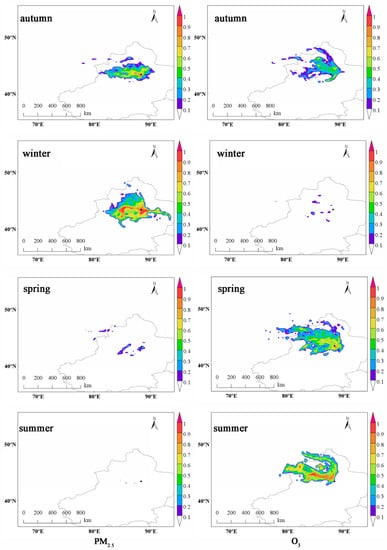
Figure 9.
Potential source contribution function (PSCF) analysis of PM2.5 and O3 in Urumqi urban area in four seasons.
In winter, the WPSCF value of O3 is the lowest (WPSCF < 0.2) among the four seasons, and Karamay, Tacheng, Urumqi, and Bayingolin contributed most to the O3 concentrations in the urban area. In autumn, the WPSCF values were large (WPSCF > 0.6). Shihezi, Turpan, Jimusar, and some areas bordering Kazakhstan in Tacheng were the MSAs. In spring, WPSCF values were high, and the area of MSAs was larger than that in autumn. Jimusar, Turpan, Urumqi, Shihezi, Urumqi, Ili, Bortala, Tacheng, and Bayingolin were the MSAs. In summer, the MSAs were Wusu, Shihezi, Urumqi, Xinyuan, the Kazakhstan-Alataw pass border zone, Tacheng, and Altay (WPSCF > 0.7).
3.5.2. CWT Analysis
The PSCF analysis only reflects the proportion of polluted trajectories in each grid to the total number of trajectories passing through the grid, not the degree of pollution in the grid [61,62]. Therefore, in this study, the weighted calculation of the CWT analysis was conducted to further determine the concentration contribution of potential source areas (Figure 10).
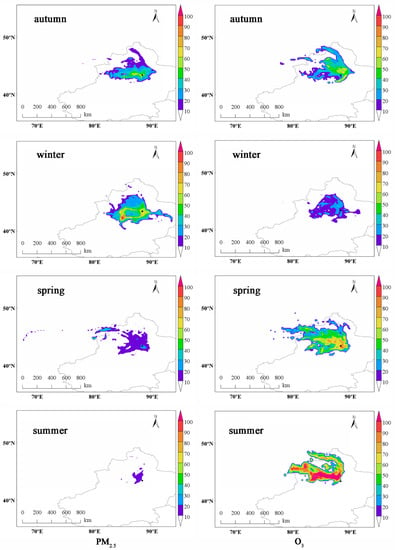
Figure 10.
Concentration weighted trajectory (CWT) analysis of PM2.5 and O3 concentration in the urban area of Urumqi in four seasons.
In winter, the WCWT value was low (10 μg/m3 < WCWT < 30 μg/m3), and Urumqi, Shihezi, Ili, Bayingolin, and Tacheng contributed most to the O3 concentrations in the urban area. The distribution of WCWT values in autumn and spring was similar, and Turpan, Urumqi, and Jimsar contributed most to the O3 concentrations in the urban area (40 μg/m3 < WCWT < 70 μg/m3). In spring, the cities around Urumqi (Turpan, Shihezi, etc.) contributed most to the O3 concentrations in the urban area. Besides, the area of areas with a high WCWT value was larger than those in autumn. In summer, Wusu, Shihezi, and Urumqi, an area adjacent to Kazakhstan and Alataw pass, and an area on the border between Kazakhstan and Jimusar contributed most to the O3 concentrations in the urban area.
To sum up, the WPSCF and WCWT values of O3 were greater in spring and summer than in autumn and winter, with the highest in summer and the lowest in winter. This is contrary to those of PM2.5. The results of both PSCF and CWT analyses indicate that Wusu, Shihezi, Urumqi, etc., are the main source areas. The CWT analysis results of PM2.5 showed that in winter, Ili, Bayingolin, northern Turpan, and Changji contributed most to the O3 concentrations in the urban area (WCWT > 60 μg/m3). This may be due to the rapid industrial development, high population density, increased traffic exhaust emissions, and other human factors in these areas. In addition, some areas distributed in the border zones between Kazakhstan and Alataw Pass/Jimusar also had high WPSCF and WCWT values. This may lead to the transnational diffusion of pollutants.
4. Conclusions
The variation of O3 concentration in the urban and southern mountainous areas of Urumqi from October 2017 to August 2018 was analyzed and compared with the variation of particulate matter concentration over the same period. Besides, the PSCF and CWT analysis was applied to identify the potential source areas. The daily and monthly O3 concentration showed a bimodal variation (in March and July) in the urban area of Urumqi, but there was no obvious variation in the southern mountainous area. The seasonal characteristics of pollutant concentration were obvious in the urban area. PM10 concentration was high in winter and spring, and low in autumn and summer. PM2.5 and PM1 concentrations were high in autumn and winter, and low in spring and summer. O3 concentration was high in summer and low in winter. The seasonal variation of pollutant concentration was not obvious in the southern mountainous area. PM10 and PM2.5 concentrations were high in winter and low in summer. PM1 concentration had little change, and O3 concentration was slightly higher in summer than in other seasons. The daily O3 concentration showed a unimodal variation in the urban area but had different variations in the four seasons. The daily variation was the smallest in winter and the largest in summer. The daily variation of O3 concentration was not obvious in the southern mountainous area, but the O3 concentration was slightly higher in summer than in other seasons. Besides, there was a peak at about 7:00 p.m., later than the occurrence of the peak in the urban area. There was no obvious weekend effect of O3 concentration in the Urumqi urban area in autumn. However, there was an obvious negative weekend effect in winter and a positive weekend effect in spring and summer, and the weekend effect in spring was more obvious than that in summer. In the southern mountainous area, there was a negative weekend effect in autumn, winter, and spring, and the weekend effect continued to decrease. Besides, there was an obvious positive weekend effect in summer.
There were obvious spatial distribution characteristics and seasonal differences in the potential source areas of PM and O3 in the urban area of Urumqi. For PM2.5, the WCWT in winter was the highest (WCWT > 60 μg/m3) among the four seasons, and Ili, Bayingolin, northern Turpan, and Changji contributed most to the PM2.5 concentrations in the urban area. For O3, the WCWT value in summer was the highest (70–100 μg/m3) among the four seasons, and Wusu, Shihezi, Urumqi, and some areas distributed in the border zones between Kazakhstan and Alataw Pass/Jimusar contributed most to the O3 concentrations in the urban area. This study deepens our understanding of the actual situation of pollution in different seasons and day and night in the urban area and mountainous areas of Urumqi and clarifies the potential sources of pollutants and intensity of contributions. This study provides a reference for the control of cross-regional transmission of pollutants.
Since no other pollutant datasets were available, this study only compared the concentration characteristics of particulate matter and ozone at different time scales and possible sources. In the future, we will combine other pollutants such as CO, SO2, NO, NO2, NOx, etc., to clarify the impact of these atmospheric pollutants on ozone concentration. In addition, since meteorological conditions are key factors in the accumulation and diffusion of pollutants, we will explore the influence of different meteorological factors such as wind direction, wind speed, air temperature, air pressure, and humidity on particulate matter and ozone concentration in future studies.
Author Contributions
C.Z.: Conceptualization, Data curation, Methodology, Software, Investigation, Visualization, Writing-Original draft preparation, Writing- Reviewing and Editing. Q.H.: Funding acquisition, Investigation, Resources, Supervision, Writing-Reviewing and Editing. Z.Z.: Resources. X.L.: Resources. Z.P.: Investigation, Resources. All authors have read and agreed to the published version of the manuscript.
Funding
Research reported in this publication was supported by the Second Tibetan Plateau Scientific Expedition and Research (STEP) program (Grant No. 2019QZKK010206) and the Third Xinjiang Scientific Expedition and Research program (Grant No. 2021xjkk030501).
Acknowledgments
The authors acknowledge the Institute of Desert Meteorology, China Meteorological Administration and the NOAA for the data that they kindly provided. Thanks to Yaqiang Wang for providing technical supports for the use of Meteoinfo software.
Conflicts of Interest
The authors declare no conflict of interest.
References
- Li, K.; Jacob, D.J.; Liao, H.; Zhu, J.; Shah, V.; Shen, L.; Bates, K.H.; Zhang, Q.; Zhai, S. A two-pollutant strategy for improving ozone and particulate air quality in China. Nat. Geosci. 2019, 12, 906–910. [Google Scholar] [CrossRef]
- Zhao, H.; Chen, K.; Liu, Z.; Zhang, Y.; Shao, T.; Zhang, H. Coordinated control of PM2.5 and O3 is urgently needed in China after implementation of the “Air pollution prevention and control action plan”. Chemosphere 2020, 270, 129441. [Google Scholar] [CrossRef] [PubMed]
- Zhao, S.; Yin, D.; Yu, Y.; Kang, S.; Qin, D.; Dong, L. PM2.5 and O3 Pollution during 2015–2019 over 367 Chinese cities: Spatiotemporal variations, meteorological and topographical impacts. Environ. Pollut. 2020, 264, 114694. [Google Scholar] [CrossRef] [PubMed]
- Huang, S. Air pollution and control: Past, present and future. Chin. Sci. Bull. 2018, 63, 895–919. [Google Scholar] [CrossRef]
- Xiang, S.; Liu, J.; Tao, W.; Yi, K.; Xu, J.; Hu, X.; Liu, H.; Wang, Y.; Zhang, Y.; Yang, H.; et al. Control of both PM2.5 and O3 in Beijing-Tianjin-Hebei and the surrounding areas. Atmos. Environ. 2020, 224, 117259. [Google Scholar] [CrossRef]
- Dai, H.; Zhu, J.; Liao, H.; Li, J.; Liang, M.; Yang, Y.; Yue, X. Co-occurrence of ozone and PM2.5 pollution in the Yangtze River Delta over 2013–2019: Spatiotemporal distribution and meteorological conditions. Atmos. Res. 2021, 249, 105363. [Google Scholar] [CrossRef]
- Lou, S.; Liao, H.; Zhu, B. Impacts of aerosols on surface-layer ozone concentrations in China through heterogeneous reactions and changes in photolysis rates. Atmos. Environ. 2014, 85, 123–138. [Google Scholar] [CrossRef]
- Qu, Y.; Wang, T.; Cai, Y.; Wang, S.; Chen, P.; Li, S.; Li, M.; Yuan, C.; Wang, J.; Xu, S. Influence of atmospheric particulate matter on ozone in Nanjing, China: Observational study and mechanistic analysis. Adv. Atmos. Sci. 2018, 35, 1381–1395. [Google Scholar] [CrossRef]
- Juráň, S.; Grace, J.; Urban, O. Temporal Changes in Ozone Concentrations and Their Impact on Vegetation. Atmosphere 2021, 12, 82. [Google Scholar] [CrossRef]
- Yan, M.L.; Li, T.T.; Liu, X.T.; Duan, H.Y.; Liu, Z.R. Human health effects of short-term ozone exposure: A review of Chinese epidemiological evidence. J. Environ. Health 2012, 29, 752–761. [Google Scholar] [CrossRef]
- Schlink, U.; Herbarth, O.; Richter, M.; Dorling, S.; Nunnari, G.; Cawley, G.; Pelikan, E. Statistical models to assess the health effects and to forecast ground-level ozone. Environ. Model. Softw. 2006, 21, 547–558. [Google Scholar] [CrossRef]
- Aunan, K.; Pan, X.C. Exposure-response functions for health effects of ambient air pollution applicable for China—A meta-analysis. Sci. Total. Environ. 2004, 329, 3–16. [Google Scholar] [CrossRef] [PubMed]
- Jerrett, M.; Burnett, R.T.; Pope, C.A.; Ito, K.; Thurston, G.; Krewski, D.; Shi, Y.; Calle, E.; Thun, M. Long-term ozone exposure and mortality. N. Engl. J. Med. 2009, 360, 1085–1095. [Google Scholar] [CrossRef] [PubMed]
- Katanoda, K.; Sobue, T.; Satoh, H.; Tajima, K.; Suzuki, T.; Nakatsuka, H.; Takezaki, T.; Nakayama, T.; Nitta, H.; Tanabe, K.; et al. An association between long-term exposure to ambient air pollution and mortality from lung cancer and respiratory diseases in Japan. J. Epidemiol. 2011, 21, 132–143. [Google Scholar] [CrossRef] [PubMed]
- Zhou, M.J.; Hu, W.Q.; Yang, S.Y.; Zhu, X.; Zhao, C.C.; Bai, Z.Y. Spatial-temporal analysis of PM2.5-related health impact and economic losses in China from 2000 to 2017. J. Cent. China Norm. Univ. (Nat. Sci. Ed.) 2021, 55, 110–120. [Google Scholar] [CrossRef]
- Zhou, T. New physical science behind climate change: What does IPCC AR6 tell us? Innovation 2021, 2, 100173. [Google Scholar] [CrossRef]
- An, Z.; Huang, R.-J.; Zhang, R.; Tie, X.; Li, G.; Cao, J.; Zhou, W.; Shi, Z.; Han, Y.; Gu, Z.; et al. Severe haze in Northern China: A synergy of anthropogenic emissions and atmospheric processes. Proc. Natl. Acad. Sci. USA 2019, 116, 8657–8666. [Google Scholar] [CrossRef]
- Fu, T.-M.; Zheng, Y.; Paulot, F.; Mao, J.; Yantosca, R.M. Positive but variable sensitivity of August surface ozone to large-scale warming in the southeast United States. Nat. Clim. Chang. 2015, 5, 454–458. [Google Scholar] [CrossRef]
- Allen, S.K.; Plattner, G.K.; Nauels, A.; Xia, Y.; Stocker, T.F. Climate Change 2013: The Physical Science Basis. An overview of the Working Group 1 Contribution to the Fifth Assessment Report of the Intergovernmental Panel on Climate Change (IPCC). 2014. Available online: https://ui.adsabs.harvard.edu/abs/2014EGUGA..16.3544A/abstract (accessed on 13 March 2023).
- Zhang, Q.; Yang, J.; Wang, W.; Ma, P.; Lu, G.; Liu, X.; Yu, H.; Fang, F. Climatic Warming and Humidification in the Arid Region of Northwest China: Multi-Scale Characteristics and Impacts on Ecological Vegetation. J. Meteorol. Res. 2021, 35, 113–127. [Google Scholar] [CrossRef]
- Wang, P.; Guo, H.; Hu, J.; Kota, S.H.; Ying, Q.; Zhang, H. Responses of PM2.5 and O3 concentrations to changes of meteorology and emissions in China. Sci. Total Environ. 2019, 662, 297–306. [Google Scholar] [CrossRef]
- Cristofanelli, P.; Bonasoni, P. Background ozone in the southern Europe and Mediterranean area: Influence of the transport processes. Environ. Pollut. 2009, 157, 1399–1406. [Google Scholar] [CrossRef] [PubMed]
- Wang, Y.T.; Zhang, Q.; Wen, X.Y.; Dou, N.C.; Zhao, W.T.; Luo, S.Z.; Chen, Z.; Qu, C.K. Spatial and temporal distribution of PM2.5 and seasonal analysis of potential source areas in Yuncheng City. Environ. Sci. 2022, 43, 74–84. [Google Scholar] [CrossRef]
- Liu, H.; Wang, Y.; Wang, S.T.; Liu, Y.; Li, B. Transport path of particulate matter in Tian shui City based on HYSPLIT4 model. China Environ. Sci. 2021, 41, 3529–3538. [Google Scholar] [CrossRef]
- Li, H.L.; He, Q.; Liu, X.C.; Zhao, Q.W. Transport path and potential source of PM10 in eastern Pamir Plateau. China Environ. Sci. 2020, 40, 4660–4668. [Google Scholar] [CrossRef]
- Sassen, K. Indirect climate forcing over the western US from Asian dust storms. Geophys. Res. Lett. 2002, 29, 103-1–103-4. [Google Scholar] [CrossRef]
- Kumar, R.; Barth, M.C.; Madronich, S.; Naja, M.; Carmichael, G.R.; Pfister, G.G.; Knote, C.; Brasseur, G.P.; Ojha, N.; Sarangi, T. Effects of dust aerosols on tropospheric chemistry during a typical pre-monsoon season dust storm in northern India. Atmos. Chem. Phys. 2014, 14, 1113–1158. [Google Scholar] [CrossRef]
- Li, K.; Jacob, D.J.; Liao, H.; Shen, L.; Zhang, Q.; Bates, K.H. Anthropogenic drivers of 2013–2017 trends in summer surface ozone in China. Proc. Natl. Acad. Sci. USA 2019, 116, 422–427. [Google Scholar] [CrossRef]
- Gryparis, A.; Forsberg, B.; Katsouyanni, K.; Analitis, A.; Touloumi, G.; Schwartz, J.; Samoli, E.; Medina, S.; Anderson, H.R.; Niciu, E.M.; et al. Acute effects of ozone on mortality from the “Air Pollution and health: A European approach” project. Am. J. Respir. Crit. Care Med. 2004, 170, 1039–1135. [Google Scholar] [CrossRef]
- Peng, R.D.; Samoli, E.; Pham, L.; Dominici, F.; Touloumi, G.; Ramsay, T.; Burnett, R.T.; Krewski, D.; Le Tertre, A.; Cohen, A.; et al. Acute effects of ambient ozone on mortality in Europe and North America: Results from the APHENA study. Air Qual. Atmos. Health 2013, 6, 445–453. [Google Scholar] [CrossRef]
- Li, D.; Liu, J.; Zhang, J.; Gui, H.; Du, P.; Yu, T.; Wang, J.; Lu, Y.; Liu, W.; Cheng, Y. Identification of long-range transport pathways and potential sources of PM2.5 and PM10 in Beijing from 2014 to 2015. J. Environ. Sci. 2017, 56, 214–229. [Google Scholar] [CrossRef]
- Chen, L.; Zhu, J.; Liao, H.; Yang, Y.; Yue, X. Meteorological influences on PM2.5 and O3 trends and associated health burden since China’s clean air actions. Sci. Total Environ. 2019, 744, 140837. [Google Scholar] [CrossRef] [PubMed]
- Zeng, Y.; Hopke, P. A study of the sources of acid precipitation in Ontario, Canada. Atmos. Environ. (1967) 1989, 23, 1499–1509. [Google Scholar] [CrossRef]
- Wang, Y.Q.; Zhang, X.Y.; Draxler, R.R. TrajStat: GIS-based software that uses various trajectory statistical analysis methods to identify potential sources from long-term air pollution measurement data. Environ. Model. Softw. 2009, 24, 938–939. [Google Scholar] [CrossRef]
- Li, Y.J.; An, X.Q.; Fan, G.Z. Transport pathway and potential source area of atmospheric particulates in Beijing. China Environ. Sci. 2019, 39, 915–927. [Google Scholar] [CrossRef]
- Polissar, A.V.; Hopke, P.K.; Harris, J.M. Source regions for atmospheric aerosol measured at Barrow, Alaska. Environ. Sci. Technol. 2001, 35, 4214–4226. [Google Scholar] [CrossRef]
- Polissar, A.; Hopke, P.; Paatero, P.; Kaufmann, Y.; Hall, D.; Bodhaine, B.; Dutton, E.; Harris, J. The aerosol at Barrow, Alaska: Long-term trends and source locations. Atmos. Environ. 1999, 33, 2441–2458. [Google Scholar] [CrossRef]
- Sun, L.; Xue, L.; Wang, Y.; Li, L.; Lin, J.; Ni, R.; Yan, Y.; Chen, L.; Li, J.; Zhang, Q.; et al. Impacts of meteorology and emissions on summertime surface ozone increases over central eastern China between 2003 and 2015. Atmos. Chem. Phys. 2019, 19, 1455–1469. [Google Scholar] [CrossRef]
- Zhang, Z.; Zhang, X.; Gong, D.; Quan, W.; Zhao, X.; Ma, Z.; Kim, S.-J. Evolution of surface O3 and PM2.5 concentrations and their relationships with meteorological conditions over the last decade in Beijing. Atmos. Environ. 2015, 108, 67–75. [Google Scholar] [CrossRef]
- Shao, P.; An, J.; Xin, J.; Wu, F.; Wang, J.; Ji, D.; Wang, Y.S. Source apportionment of VOCs and the contribution to photochemical ozone formation during summer in the typical industrial area in the Yangtze River Delta, China. Atmos. Res. 2016, 176–177, 64–74. [Google Scholar] [CrossRef]
- Liu, T.; Wang, X.; Hu, J.; Wang, Q.; An, J.; Gong, K.; Sun, J.; Li, L.; Qin, M.; Li, J.; et al. Driving forces of changes in air quality during the COVID-19 lockdown period in the Yangtze River Delta region, China. Environ. Sci. Technol. Lett. 2020, 7, 779–786. [Google Scholar] [CrossRef]
- Wang, Y.; Zhu, S.; Ma, J.; Shen, J.; Wang, P.; Wang, P.; Zhang, H. Enhanced atmospheric oxidation capacity and associated ozone increases during COVID-19 lockdown in the Yangtze River Delta. Sci. Total Environ. 2021, 768, 144796. [Google Scholar] [CrossRef] [PubMed]
- Wang, N.; Lyu, X.; Deng, X.; Huang, X.; Jiang, F.; Ding, A. Aggravating O3 pollution due to NOx emission control in eastern China. Sci. Total Environ. 2019, 677, 732–744. [Google Scholar] [CrossRef] [PubMed]
- Ji, J.; Wang, G.; Du, X.L.; Jin, C.; Yang, H.L.; Liu, J.; Yang, Q.L.; Tchouopou, L.J.; Li, J.; Chang, C.T. Evaluation of Adsorbing Haze PM2.5 Fine Particulate Matters with Plants in Beijing-Tianjin-Hebei Region in China. Sci. China Life Sci. 2013, 43, 6. [Google Scholar] [CrossRef]
- Zhu, C.Y.; He, Q.; Zhao, Z.J.; Liu, X.C.; Pu, Z.C. Comparative analysis of particulate matter pollution characteristics between urban area and southern suburb of Urumqi. China Environ. Sci. 2022, 42, 4073–4085. [Google Scholar] [CrossRef]
- Ragland, K. A comparison of weekend-weekday ozone and hydrocarbon concentrations in the Baltimore-Washington metropolitan area. Atmos. Environ. 1976, 10, 564. [Google Scholar] [CrossRef]
- Li, C.L. Analysis on variation characteristics of ozone and correlation with meteorological elements in urban atmosphere of Xuzhou. Environ. Sci. Manag. 2018, 43, 77–81. [Google Scholar] [CrossRef]
- Geng, F.; Tie, X.; Xu, J.; Zhou, G.; Peng, L.; Gao, W.; Tang, X.; Zhao, C. Characterizations of ozone, NOx, and VOCs measured in Shanghai, China. Atmos. Environ. 2008, 42, 6873–6883. [Google Scholar] [CrossRef]
- Chen, J.; Shen, H.; Li, T.; Peng, X.; Cheng, H.; Ma, C. Temporal and spatial features of the correlation between PM2.5 and O3 concentrations in China. Int. J. Environ. Res. Public Health 2019, 16, 4824. [Google Scholar] [CrossRef]
- Zhu, J.; Chen, L.; Liao, H.; Dang, R. Correlations between PM2.5 and ozone over China and associated underlying reasons. Atmosphere 2019, 10, 352. [Google Scholar] [CrossRef]
- Chen, Y.Z.; Zhao, D.; Chai, F.H.; Liang, G.X.; Xue, Z.G.; Wang, B.B.; Liang, Y.J.; Chen, Y.; Zhang, M. Correlation between the atmospheric visibility and aerosol fine particle concentrations in Guangzhou and Beijing. China Environ. 2010, 30, 967–971. [Google Scholar] [CrossRef]
- Tian, X.L.; Xie, Z.H.; Liu, M.X.; Yang, N.; Ren, Y.T.; Cheng, B.W. Changes in O3 and PM2.5 Concentrations and Characteristics of Composite Pollution in Tangshan City from 2014 to 2020. In Proceedings of the 2021 Annual Scientific and Technical Conference of the Chinese Society for Environmental Science (I), Surakarta, Indonesia, 24–25 August 2021; pp. 580–586. Available online: http://cpfd.cnki.com.cn/Article/CPFDTOTAL-HJKP202110001084.htm (accessed on 13 March 2023).
- Yan, F.H.; Chen, W.H.; Chang, M.; Wang, W.W.; Liu, Y.L.; Zhong, B.Q.; Mao, J.Y.; Yang, S.S.; Wang, X.M.; Liu, S.F. Characteristics and Meteorological Factors of Complex Nonat-tainment Pollution of Atmospheric Photochemical Oxidant (Ox) and PM2.5 in the Pearl River Delta Region, China. Huan Jing Ke Xue 2021, 42, 1600–1614. [Google Scholar] [CrossRef] [PubMed]
- Guan, Q.; Zheng, Y.F.; Zhao, H.; Yuan, Y.; Wang, Y. Effects of PM2.5 and Meteorological Factors on Ozone in Urumqi. Sci. Technol. Eng. 2019, 19, 7. [Google Scholar] [CrossRef]
- Deng, X.J.; Zhou, X.J.; Wu, D.; Tie, X.X.; Tan, H.B.; Li, F.; Bi, X.Y.; Deng, T.; Jiang, D.H. Effect of atmospheric aerosol on surface ozone variation over the Pearl River Delta region. Sci. China (Earth Sci.) 2011, 41, 93–102. [Google Scholar] [CrossRef]
- Chen, S.; Wang, H.; Lu, K.; Zeng, L.; Hu, M.; Zhang, Y. The trend of surface ozone in Beijing from 2013 to 2019: Indications of the persisting strong atmospheric oxidation capacity. Atmos. Environ. 2020, 242, 117801. [Google Scholar] [CrossRef]
- Shao, P.; Xin, J.Y.; An, J.L.; Wang, J.X.; Wu, F.K.; Wang, Y. An analysis on the relationship between ground-level ozone and particulate matter in an industrial area in the Yangtze River Delta during summertime. Chin. J. Atmos. Sci. 2017, 41, 618–628. [Google Scholar] [CrossRef]
- Ma, Y.; Wang, M.; Wang, S.; Wang, Y.; Feng, L.; Wu, K. Air pollutant emission characteristics and HYSPLIT model analysis during heating period in Shenyang, China. Environ. Monit. Assess. 2020, 193, 9. [Google Scholar] [CrossRef] [PubMed]
- Pu, W.; Shi, X.; Wang, L.; Xu, J.; Ma, Z. Potential source regions of air pollutants at a regional background station in Northern China. Environ. Technol. 2019, 40, 3412–3421. [Google Scholar] [CrossRef]
- Liao, T.; Wang, S.; Ai, J.; Gui, K.; Duan, B.; Zhao, Q.; Zhang, X.; Jiang, W.; Sun, Y. Heavy pollution episodes, transport pathways and potential sources of PM2.5 during the winter of 2013 in Chengdu (China). Sci. Total Environ. 2017, 584–585, 1056–1065. [Google Scholar] [CrossRef]
- Hopke, P.K.; Gao, N.; Cheng, M.D. Combining chemical and meteorological data to infer source areas of airborne pollutants. Chemom. Intell. Lab. Syst. 1993, 19, 187–199. [Google Scholar] [CrossRef]
- Han, Y.J.; Holsen, T.M.; Hopke, P.K. Estimation of source locations of total gaseous mercury measured in New York State using trajectory-based models. Atmos. Environ. 2007, 41, 6033–6047. [Google Scholar] [CrossRef]
Disclaimer/Publisher’s Note: The statements, opinions and data contained in all publications are solely those of the individual author(s) and contributor(s) and not of MDPI and/or the editor(s). MDPI and/or the editor(s) disclaim responsibility for any injury to people or property resulting from any ideas, methods, instructions or products referred to in the content. |
© 2023 by the authors. Licensee MDPI, Basel, Switzerland. This article is an open access article distributed under the terms and conditions of the Creative Commons Attribution (CC BY) license (https://creativecommons.org/licenses/by/4.0/).